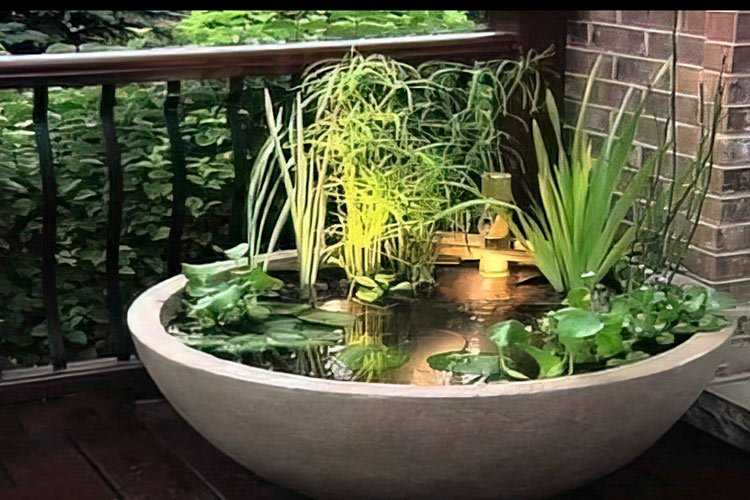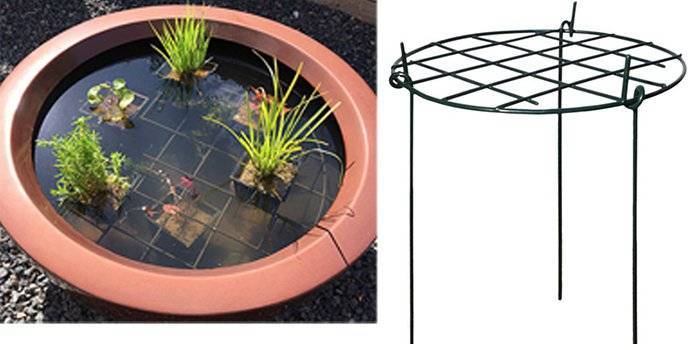Beautiful Plants For Your Interior

If you can’t build a large wildlife pond in your garden, we can show you in this post how to build a small garden pond in a container, easily. A small garden pond can be a wonderful addition to your backyard, garden or patio, adding beauty, tranquillity, and a touch of nature to your outdoor space.
However, building a pond from scratch can be a daunting task for some. That’s where building a small garden pond in a container can be an advantage to some. In this post, we’ll show you ‘how to’ easily build a small garden pond in a container, including plants to attract wildlife, providing you with a simple and cost-effective solution for creating your very own outdoor oasis in no time.
Before deciding on the type of container to use, you must determine the area in which to place your container so it will receive the correct amount of sunlight/shade. Ideally, your small garden pond should receive some morning light, which is cooler and won’t heat up the water too much or scorch your plants as the sun may in the afternoon.
Choosing the right container is not critical, for your small garden pond to be successful but there are some do’s and don’ts. You should certainly try to avoid using wooden containers (unless sealed/waterproof) as they might contain harmful bacteria or chemicals that could ‘leech’ from the wood itself. Some plastic containers may contain harmful elements and these too should also be avoided, as some plastic breaks down over time thus causing further problems.
Containers made of unglazed earthenware (terracotta pots) may need lining to prevent them from leaking or the gentle water ‘evaporation’ from the pot over time. On the other hand, stone, like granite, would make a great container as it’s non-porous and doesn’t break down, old china sinks are another favourite to use in the garden. Metal containers like old baths or half drums can also be used but need lining before use and only after a thorough clean.
Some people choose to buy proprietary kits that include the container, gravel, and all the items required to get your small garden pond up and running. This method is something that is available at a reasonable cost if you do not have a suitable container and it will save you a bit of time, instead of you searching and buying items separately.
Whatever you decide to choose, you will see containers come in all shapes and sizes and are made from different materials, so you can choose one that fits the style and theme of your garden, patio or backyard. You can also try and blend your new small garden pond in with other tubs or pots in your garden if possible.
Adding Suitable Substrate or Gravel
Once you have your container, place aquarium-grade gravel or similar water-safe substrate of around 1-3 inches (25-75mm) at the bottom of the container, you can also add some aquatic soil to create a more natural environment in your pond if you would like.
The deeper and larger your container is the better, as there will be enough room in terms of depth to use just the gravel, alternatively, you can decrease the gravel depth by a few inches (25-50mm) or so by using aquatic soil beneath the gravel to ‘root’ your plants and provide the nutrients they need.
To build a small garden pond in a deeper container, you must provide adequate support for your plants. For this, you will need plant support rings to keep your pond plants healthy and in place.
Proprietary ‘plant support rings’ are available in round or square formats, to suit your container. They simply attach/sit in your pond at the appropriate height, which is around 1-2in (25-50mm) below the surface of the water.
Then place the correct size plant pots in a square grid or round plant support, making sure the legs are not too tall, (cut to length if necessary) or the plant will flop over if the wind blows.

How to Build a Small Garden Pond in a Container: Plant Support Rings For Square Pots
Plants to Attract Wildlife
Insects and other wildlife need water and green space in order to thrive, and your small garden container pond will provide them with both. Many people enjoy the tranquillity of a small garden pond placed in a special place.
This part of our post will provide you with the information you need to start planting and attracting wildlife to your new garden water feature.
Fill up the pond/container with rainwater and add your plants (more on plants later), so they can take up enough moisture without being too saturated. If using tap water try letting it sit without plants for the first few days, just as a general rule of thumb to try and remove (evaporate) any chlorine in the water.
It is important, to make sure you place your garden container pond in a spot that receives a few hours of sunlight throughout the day. In addition, though, it’s important to make sure you keep your container pond in a predominantly shaded area because the full sun will quickly heat up a small water body. Just try and find a nice balance.
With the water in your container garden, we now need to attract some wildlife. One simple way to attract wildlife to your new pond is to plant marginal plants. Adding native marginal plants to the pond will provide perches and cover for small-sized wildlife.
For a small pond, choose two to three types of plants only. The water forget-me-not, lesser spearwort, and marsh marigold are excellent plants for these areas, plant a couple of these in the margins of your container. One of the most common plants though is the waterlily, Nymphaea ‘Laydekeri Fulgens‘. which sits on top of your pond if you have room.
When planting your container garden, make sure that your pond’s surface is covered with between 25-75% of the container with your plants. This will help ensure shelter and proper water filtration and oxygenation of the water for fish and other wildlife that may enter your small ecosystem. However, we do not recommend the introduction of fish due to the potential freezing (cold weather) or heating up (direct sunlight) of the water in your small container, as both extremes will kill any fish you have in it!
What sets off any pond though is the attraction of our best-loved British wildlife, like dragonflies, frogs, newts even birds. Unfortunately, it is just a case of waiting I am afraid. If you have created the correct environment by following my simple steps above then the wildlife will be attracted to your pond.
How to Build a Small Garden Pond in a Container: A Mini Pond Explained
Lets Re-Cap
Here is a table summarising the materials needed for a small garden pond in a container with dimensions of around 100cm wide and 60cm deep:
| Materials | Purpose |
|---|---|
| Container – 100cm x 60cm | Holds water and provides a structure for the pond |
| Pond liner to suit (optional) | Prevents water from seeping out of the container |
| Suitable gravel | Creates substrate for aquatic plants to grow in |
| Native pond plants | Provide oxygen, control algae, and create habitat |
| Water pump and filter (optional) | Maintain cleanliness of the water |
| Fish (optional) But not recommended | Adds interest to the pond and helps control insects |
| Netting (optional) | Prevents debris from falling into the water |
| Decorative rocks (optional) | Creates a more natural-looking habitat |
FAQs
How Deep Should The Container Be For a Small Garden Pond?
The container should be at least 18 inches deep (46cm) to provide enough room for plants and fish (if needed).
Do I Need a Filter For My Small Garden Pond?
While a filter isn’t necessary for a small garden pond, it can help keep the water clean and reduce maintenance. A small solar aerator pump could be suitable if you can’t run a power cable to your pond for a pump.
Can I Use Tap Water in my Garden Container Pond?
Yes, you can use tap water, but it’s best to let it sit for a few days before adding it to the pond to allow any chlorine or other chemicals to dissipate.
Conclusion
Building a small garden pond from a container is a fun and easy DIY project and all the materials required above can be purchased from your local garden or aquatic centre.
Completion of a project like this can provide you with years of enjoyment and relaxation in your garden, patio, or small backyard. By following these simple steps above and taking good care of your pond, you can create a beautiful and peaceful oasis in your outdoor space.
If you have found this post helpful, why not share it on Facebook with your friends and other garden enthusiasts?
